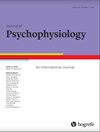Somatosensory Deviance Detection ERPs and Their Relationship to Analogous Auditory ERPs and Interoceptive Accuracy
IF 0.9
4区 心理学
Q4 NEUROSCIENCES
引用次数: 1
Abstract
Abstract. Automatic deviance detection has been widely explored in terms of mismatch responses (mismatch negativity or mismatch response) and P3a components of event-related potentials (ERPs) under a predictive coding framework; however, the somatosensory mismatch response has been investigated less often regarding the different types of changes than its auditory counterpart. It is not known whether the deviance detection responses from different modalities correlate, reflecting a general prediction error mechanism of the central nervous system. Furthermore, interoceptive functions have been associated with predictive coding theory, but whether interoceptive accuracy correlates with deviance detection brain responses has rarely been investigated. Here, we measured ERPs to changes in somatosensory stimuli’s location and intensity and in sound intensity in healthy adults ( n = 34). Interoceptive accuracy was measured with a heartbeat discrimination task, where participants indicated whether their heartbeats were simultaneous or non-simultaneous with sound stimuli. We found a mismatch response and a P3a response to somatosensory location and auditory intensity changes, but for somatosensory intensity changes, only a P3a response was found. Unexpectedly, there were neither correlations between the somatosensory location deviance and intensity deviance brain responses nor between auditory and somatosensory brain responses. In addition, the brain responses did not correlate with interoceptive accuracy. The results suggest that although deviance detection in the auditory and somatosensory modalities are likely based on similar neural mechanisms at a cellular level, their ERP indexes do not indicate a linear association in sensitivity for deviance detection between the modalities. Furthermore, although sensory deviance detection and interoceptive detection are both associated with predictive coding functions, under these experimental settings, functional relationships were not observed. These results should be taken into account in the future development of theories related to human sensory functions and in extensions of the predictive coding theory in particular.体感偏差检测ERPs及其与类似听觉ERPs和感觉准确性的关系
摘要在预测编码框架下,在失配反应(失配负性或失配反应)和事件相关电位(ERPs)的P3a成分方面,自动异常检测已被广泛探索;然而,与听觉反应相比,体感失配反应在不同类型的变化中的研究较少。目前尚不清楚来自不同模态的异常检测反应是否相互关联,这反映了中枢神经系统的一般预测误差机制。此外,内感受功能与预测编码理论有关,但内感受准确性是否与异常检测大脑反应相关的研究很少。在这里,我们测量了健康成年人(n=34)的ERPs与体感刺激的位置和强度以及声音强度的变化。通过心跳辨别任务测量感受准确性,参与者指出他们的心跳是与声音刺激同时还是不同时。我们发现了对体感位置和听觉强度变化的失配反应和P3a反应,但对于体感强度变化,只发现了P3a反应。出乎意料的是,体感位置偏差和强度偏差大脑反应之间既没有相关性,听觉和体感大脑反应之间也没有相关性。此外,大脑的反应与内感受准确性无关。结果表明,尽管听觉和体感模态中的异常检测可能基于细胞水平上类似的神经机制,但它们的ERP指数并不表明模态之间异常检测的敏感性存在线性关联。此外,尽管感觉异常检测和内感受检测都与预测编码功能有关,但在这些实验环境下,没有观察到功能关系。在未来发展与人类感官功能相关的理论时,特别是在扩展预测编码理论时,应该考虑这些结果。
本文章由计算机程序翻译,如有差异,请以英文原文为准。
求助全文
约1分钟内获得全文
求助全文
来源期刊

Journal of Psychophysiology
医学-神经科学
CiteScore
2.60
自引率
7.70%
发文量
25
审稿时长
>12 weeks
期刊介绍:
The Journal of Psychophysiology is an international periodical that presents original research in all fields employing psychophysiological measures on human subjects. Contributions are published from psychology, physiology, clinical psychology, psychiatry, neurosciences, and pharmacology. Communications on new psychophysiological methods are presented as well. Space is also allocated for letters to the editor and book reviews. Occasional special issues are devoted to important current issues in psychophysiology.
 求助内容:
求助内容: 应助结果提醒方式:
应助结果提醒方式:


